 |
 |
 |
A Nintendo community
by the fans!
|
 |
 |
∧ |
Forum main |
|
 |
 |
|
 |
 |
|
 |
 |
 |
 |
 |
 |
 The Legend of Zelda (NES) The Legend of Zelda (NES), the first game in the Zelda franchise, was a breath of fresh air for the videogame industry. It was played from a top down perspective and provided the player with a long quest (or two) and lots of explorations and secrets. The second game, Zelda II: The Adventure of Link (NES), was played mostly from a 2D side scrolling perspective. Though, it’s a great game on it’s own, it is considered by many to be the black sheep of the family when compared to the rest of the franchise. When The Legend of Zelda: A Link to the Past (SNES) was released in 1991, it was regarded as a return to form for the franchise and is considered by many to be be one of the best games ever made. The Zelda franchise continued to evolve and eventually, became a franchise primarily designed and played from a 3rd person perspective (see The Legend of Zelda: Ocarina of Time). The last Zelda game to be designed from a top down view and played with traditional controls was The Legend of Zelda: The Minish Cap for the Game Boy advance, released in 2005. Almost nine years later, Nintendo has once again returned to form by releasing The Legend of Zelda: A Link Between Worlds, a direct sequel to A Link to the Past, set in the exact same world as ALTTP. It’s been 22 years since we’ve visited this particular iteration of Hyrule. Does the game live up to the hype? Does a Zelda game with a top down perspective and traditional controls still have a place in this day and age? Let’s find out… Let’s get the worst part of the game, over with. The story in a ALBW is basically just a retread of A Link to the Past’s and Ocarina of Time’s stories. A young boy named Link has a dream. Through a series of circumstances, he ends up in Hyrule Castle where he meets Princess Zelda and embarks upon a quest to find three magical stones. Once he has them, he goes to find the “Blade of Evil’s Bane,” in order to be able to defeat the great evil. But of course, then you find out that you have to travel to another world to free the seven sages before you have the power to do so.  The main characters from both Hyrule and Lorule. The main characters from both Hyrule and Lorule.While the story itself is not original, there are a few bits that stand out. Instead of Agahnim, we have Yuga, who merges with Ganon in order to become powerful enough to rule the world. However, Yuga answers to someone else and it is not clear who until the very end. Additionally, instead of the Dark World or Future Hyrule, we are introduced to Lorule, a darker version of Hyrule where hope has been lost and darkness rules.  For months before the game was released….I thought Yuga was a woman. For months before the game was released….I thought Yuga was a woman.I do have a few more qualms about the story, which are spoilery. The fact that you can choose any dungeon (more on this later) limits the amount of storytelling. For example, whereas in OOT you would know where to go because people (and Navi) would guide you during your quest, the same doesn’t really happen much in ALBW. Also, Ganon is relegated to a grunt in this game. In other games, he is the main bad guy and the mastermind behind all events. Heck, he even outsmarted Link and Zelda into finding the spiritual stones for him in OOT. Here, he just accepts melding with Yuga and that’s as much of his interaction as we see. His new incarnation as YuGanon (that’s what I call him) is mostly led by Yuga. I do have to say, the twists at the end of the game are really awesome. And the ending is quite fitting, which makes me wonder if we’ll see further adventures in the land of Lorule. 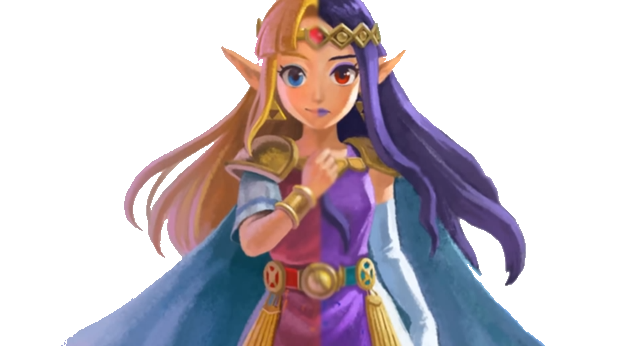 What do you think Zelda and Hilda? Wait a minute….Zelda and Hilda….Zelda and Hilda….Why does that seem so familiar? What do you think Zelda and Hilda? Wait a minute….Zelda and Hilda….Zelda and Hilda….Why does that seem so familiar?The Graphics in ALBW are very well done. The best way to describe them is ALTTP upgraded and chibified. The characters are cute and rounded, as is the game world. In fact, the game world looks much better since our last visit to this particular terrain configuration of Hyrule in ALTTP. The colors are more vibrant and the world looks like you’re actually looking into the world, as opposed to just looking at sprites. There’s a sense of depth with or without the 3D on. According to Iwata Asks: The Legend of Zelda: A Link Between Worlds, the top down effect required some trickery to work. Initially, all you could see was the top of Link’s hat. In order to see more of him, they had to tilt Link and all other characters backwards. The camera is also closer to the ground than it is in ALTTP. You can see how it works in the following picture.  Limbo anyone? Limbo anyone?Speaking of 3D, the effect in this game is one of the best I’ve seen on the system. It adds dimension to the game, as well as making your trek through the world that much more realistic. For example, in the Tower of Hera, you press down jumping pads with your hammer and launch yourself to the next level. But we actually see Link transition from one level to the next seamlessly, rather than fading to black and appearing in another room. It makes more sense when you see it in action. 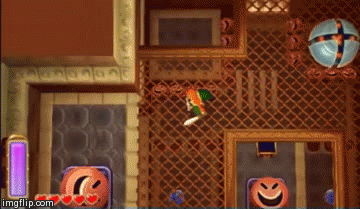 It looks even better in-game. It looks even better in-game.The graphics are also really smooth (60 frames per second) and have a lot of attention to detail. At the beginning of the game, you can see a fog close to the ground as if it were morning in a high altitude region. It makes me wish the game had day/night cycles. One of the best effects in this game is the movement of the water. It is beautifully animated and makes the world come alive. There are also some nice graphical details such as paintings on walls that you can see better when you yourself are in “painting mode.” And if you go into painting mode with items equipped, they too can be seen on “Painting Link.” 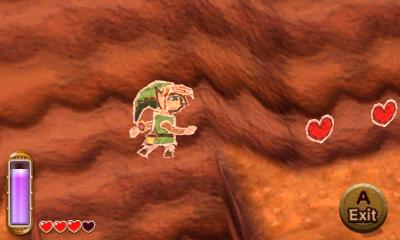 Notice the lamp hanging from his waist Notice the lamp hanging from his waistThe sound effects in ALBW sound great. The designers made a great decision in keeping the old sound effects from ALTTP but upgrading them slightly for this game. So, while the game sounds nostalgic, it also sounds new. The dying sound is still annoying, though not as annoying as in other games. I would have prefered the Wind Waker sound effect, though, but I understand that they kept the ALTTP one for consistency. The soundtrack, on the other hand, is fully redone. And it’s spectacular! I’d say it may be the best soundtrack of any Zelda game, period. Almost every piece from ALTTP has been redone and the vast majority are better than the originals. Right from the very title screen, you know you’re in for an aural treat. One of the best things about the soundtrack is how it evolves as you delve further into the game. For example, the Overworld Theme transitions through 3 stages ( 1, 2, 3) each one more epic than the last. The same goes for the Hyrule Castle theme. It starts out as a poor imitation of the original. I was severely disappointed when I heard it. Then, when you come back to the castle later during the game and it has turned into an actual dungeon level, the music changes into this masterful rendition. Some other awesome redone songs include: Lost Woods (very similar to the original), Lorule Overworld (this song has a killer intro and a great instrumental feel), Death Mountain (one of the coolest remixes in the game), and Treacherous Tower (perhaps my favorite remix in the entire game; originally the Dark World Palace Theme). Of course, there’s some cool new original music as well. There’s The Lost Woods in Lorule (sounds very un-Zeldaish), the Maimai Song (which turns bizarre, in a good way, every time you collect 10 maimais), Hilda’s Theme (which is far better than Zelda’s Lullaby), The Dark Palace (which is creepy and haunting at the same time), Ravio’s Theme (sounds very Mario-ish), Ice Palace Ruins (which is beautiful and mysterious), and my favorite new song, Cucco Mini Game (it’s just so damn fun!). And last but not least, there’s a musical duo in the Milk Bar that plays “live renditions” of the game’s soundtrack, just like K.K. Slider in Animal Crossing. Some of the best are: Overworld Theme, Kakariko Village, and Hyrule Castle. As amazing as the game’s music is, ALBW shines best in the gameplay department. Link has never controlled more easily or effortlessly . This is due to a combination of the C-Pad, physical buttons, and touch screen elements. When you move Link with the C-Pad, it feels like you’re slicing through hot butter with adamantium. It feels even better than how he controls in Wind Waker HD. Most buttons are used in traditional ways, controlling the sword and items. The D-Pad is used to move the screen a bit in 4 directions (up, down, left, right). And everything is as responsive as it should be. You can also use the touchscreen in multiple ways. You can see the world map (which you can zoom into), place pins on the map, view your items, AND select them. Unfortunately, you can’t select them live, “as in” while you’re moving about, which would have been perfect, but you can place the items in a little window so you can scroll through them quickly and select them live from there. It’s a bit awkward so I prefered selecting them from the menu.  A few of the things you can do with the touchscreen. A few of the things you can do with the touchscreen.Something that's a little different from ALTTP is that you can’t save your game anywhere. You have to go to a weather vane, of which there are many in the world, and save there. Afterwards, you can restart your game from the last weather vane you saved at, which is pretty convenient.  Screw you, weather vane! I do what I want! Screw you, weather vane! I do what I want!The weather vanes also double as transport points on the map, just like the flute in ALTTP. Here, you will be transported by apprentice witch, Irene, who will pick you up, after you ring a bell, and take you to the weather vane of your choosing.  Travel and sass, just like a taxi driver. Travel and sass, just like a taxi driver.If you don’t know where to go, you can resort to the tried and true method of going to the fortune teller, who will give you hints on where you need to go. Or, you can try something new. In Nintendo’s neverending quest to make their games more accessible via hint/help systems, Nintendo has introduced Hint Ghosts. These are ghosts that you can only see if you’re wearing special glasses. They will provide hints on what you need to do in certain places if you pay them a Play Coin (the coins you earn by walking with your 3DS). This is a pretty cool way of making the game easier, without actually dumbing it down for advanced players. It’s there if you want to use it, but it doesn’t get in your way. 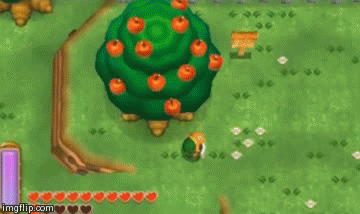 Very useful and non-obstructive. Very useful and non-obstructive.A Link Between Worlds tries do something new with its item collection system. Instead of finding items inside dungeons, as in every other Zelda game, Link has to rent items from a curious fellow who has set up shop in his house. This quirky fellow goes by the name of Ravio and his introduction marks a radical departure from previous Zelda games. There are numerous dungeons throughout the game and each has a symbol in front of it detailing what item you need to have to progress inside the dungeon. In order to obtain said items, you have to go to Ravio and rent them for a small fee. If you die (and have no fairies) Ravio’s little friend, Sheerow, will swoop in and collect the rentals. You will have to rent these items again if you want to use them. Or you can just buy them outright for a much higher fee, after you progress further in the game. This makes rupees far more important than they’ve ever been in any previous Zelda game.  Any resemblance to Nabbit is coincidental. Any resemblance to Nabbit is coincidental.I am of two minds about this new feature. I find it refreshing that you can tackle the dungeons in almost any order. But, I miss the satisfaction of gaining the items through hard work and exploration in the dungeons. Now, beating a dungeon feels a little less fulfilling. It also diminished the amount of guided storytelling, as I mentioned before, that you find in entries such as Ocarina of Time, since you can tackle the game in whatever order you want. But I do applaud Nintendo for trying something new. Another new feature regarding the items is that they consume magic energy instead of stock, like in previous Zelda games. For example, using a bomb will not deplete bomb stock (there isn’t any), it will deplete magic energy which replenishes automatically. Which also means that you don’t buy potions to replenish magic. There are still potions, though. Four types in fact. The red and blue potions restore hearts (8 and all, respectively). The yellow potion makes Link invulnerable and the purple potion damages all surrounding enemies. You will need monster remains (tails, horns, and guts), in addition to rupees, to order the blue, yellow, and purple potions. 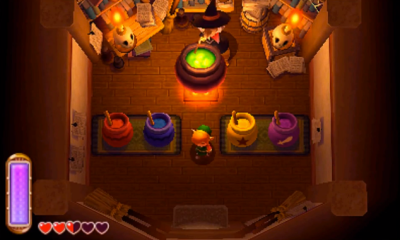 Double double, toil and trouble... Double double, toil and trouble...The most important new feature of the game, though, is turning into a wall painting. You will gain this ability after defeating the first dungeon. The moment when Link first comes out of the wall is really well done. It reminded me of David Copperfield coming out of the Great Wall of China in 1986. The mechanic is not a throwaway feature, either. It is used in the ENTIRE GAME. You can use it (by pressing “A”) to blend into the wall and reach places you couldn’t before, to surprise NPC’s, and even to travel through the worlds of Lorule and Hyrule (through glowing fissures in the environment), among other things. It uses your magic meter and, when the meter runs out, you un-blend from the wall. It is one of the most original ideas I’ve seen in gaming and it is extremely fun to do. Not only that, but it opens up the puzzle aspects of the game to new dimensions, no pun intended. Speaking of dimensions, this game is meant to be played in 3D (sorry 2DS owners). When Link turns into a painting, the view switches from a 3D over the top view, to a 2D side view; the switch is not jarring at all. 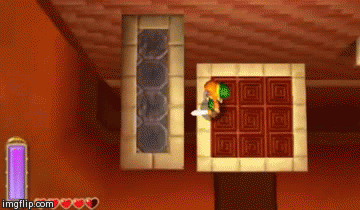 This never ceases to be fun. This never ceases to be fun.As mentioned before, there are two worlds in this game, Hyrule and Lorule. Hyrule is the land ruled by Princess Zelda and home to Link, where most of his adventures take place. Lorule, is a Dark Version of Hyrule, reminiscent of the Dark World from A Link to the Past, though not the same place. For the effect of the game, though, it’s pretty much this game’s version of the Dark World. The terrain looks similar, the musics is a remix of the Dark World, even most of the enemies and dungeons are the same or similar. Lorule even has it’s version of the Lost Woods, which earns its name back. 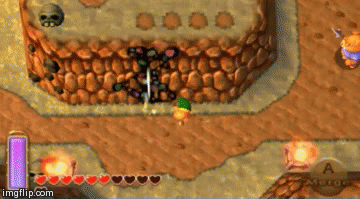 This takes too long each and every time. This takes too long each and every time.The dungeons themselves are some of the best designed dungeons in the entire franchise. While they are in basically the same locations as in ALTTP (except for two), the schematics are entirely different. One issue that arises from being able to go to any dungeon at any time is that the designers couldn’t make the enemies too difficult, or else, few people would actually be able to finish the game. The more I played, the more I realized that they went around this problem by making the puzzles in the dungeon more difficult that in previous games. That way, there is still a mental challenge, even if there isn’t much of a physical one. The dungeons themselves are a treat! There some clever puzzles that utilize 3D, wall merging, stealth, light/dark mechanics, etc. There’s also mini-bosses and dungeon warps, just like in Link’s Awakening. There’s even one dungeon that takes place in Hyrule and Lorule. One of the most clever elements of dungeons is using enemies to help you solve puzzles, such as the wall masters. It’s a very entertaining strategy and you’ll feel really smart when you realize how to solve puzzles using that method. Perhaps the most insane dungeon is the Ice Palace, where you can reach all six floors from the very beginning, but actually connecting through them will be difficult. 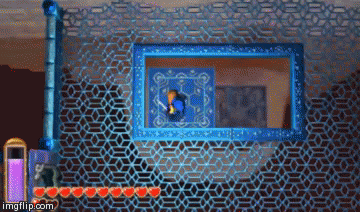 This dungeon is something else! This dungeon is something else!Of course, no Zelda game is complete without sidequests. Some of the side-quests include: collecting Maiamais, bottles, bees, and pieces of hearts. Maiamais are little Octorock-looking creatures that are hidden throughout the environment. Every time you collect 10 and take them to Mother Maiamai, you’ll be able to upgrade purchased items. It’s a very rewarding way of encouraging a collect-a-ton.  ”My, oh my, what a big mouth you have!” ”My, oh my, what a big mouth you have!”And of course, there are also mini-games. There’s the old staples like, “guess what’s in the box,” and “dig up treasure.” But there’s new fun ones such as “Evade the Cuccos” and even “Baseball.” The Baseball game is kind of weird to figure out but it’s fun nonetheless. 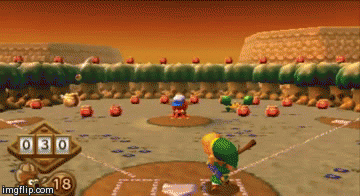 Swing batter, batter, ssssssswiiiiiiing batter! Swing batter, batter, ssssssswiiiiiiing batter!In addition to using the 3DS’ Play Coin feature, ALBW also uses Streetpass functionality in a fun way. When you StreetPass other players who own the game and have activated the Streetpass feature in-game, you’ll be able to play against their “Shadow Link” which is a version of their Link which is as strong as they are,equipped with two items of their choice. The stronger the Shadow Link, the higher the bounty (amount of rupees) you can collect from defeating them. There is no penalty for losing and if you win, you get rupees, so this is a pretty nifty feature. 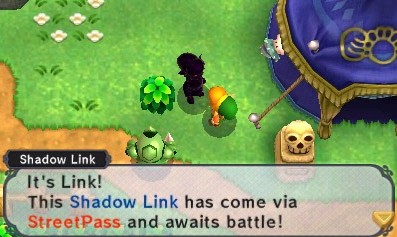 Making your Shadow Link stronger for others to fight becomes an issue of much pride. Making your Shadow Link stronger for others to fight becomes an issue of much pride.Last, but not least, after you beat the game for the first time, you unlock “Hero Mode.” The main difference between Normal and Hero Mode is that damage is quadrupled. You can still collect hearts from enemies, unlike Hero Mode in other Zeldas. Hero Mode is extremely challenging and makes up for the easy difficulty of the main game. “The Legend of Zelda: A Link Between Worlds” is the Zelda game I’ve been wanting to play for decades. While all the other top down Zelda games have been excellent, none have really captured the magic, for me, that “A Link to the Past” had. The game plays, looks, and sounds like a dream come true. While it is not a perfect game (is there even such a thing) I still consider it to be one of the greatest games ever made, just like its predecessor “A Link to the Past.” I think Nintendo should take the following approach from now on: make 3rd person Zelda games for the consoles and top-down Zelda games for the handhelds. It works to each system’s strengths and pleases fans of both types of games. As long as Nintendo develops the following top-down games with the same love and care as they did with this one, this could mark the beginning of a beautiful neo-retro era for the Zelda franchise. Notes and Trivia (SPOILERS):Starts with the same music as A Link to the Past.
You are named Link in the file.
Throwbacks to other games:
Gulley: I’m just a kid (taken from Link’s Awakening)
Ravio: Mr. Hero (taken from Ocarina of Time)
Lakeside Item Seller: C’mon. Buy somethin’? (taken from The Legend of Zelda). His Lorule counterpart actually says “Buy Somethin Will Ya” backwards.
Thief Girl: "Oh, thank you very much. You saved my life. Now take me outside." (taken from A Link to the Past).
The Stylish Woman in Hyrule looks just like the Fat Fairy from ALTTP.
The sound the weather vane makes when you save is the flute’s melody from ALTTP. Characters from other games:
Dampe (both worlds)
Impa
Zelda
Sahasrahla
Milk Bar Owner (Talon)
Ganon
Ingo (Lorule Milk Bar Owner; Nice touch) Cuccos still summon other cuccos if you hit them a lot.
Pendants: Courage, Wisdom, PowerFinally! An explanation as to why Zoras attack people!
You can see the Hyrule Castle Guards trapped in the walls as paintings.
Sages appear in the Sage Room from OOT
Cuccos are buzzards in Lorule
Majora’s Mask is hanging from a wall in your house.
A picture of the Ocarina of time and the logo from Wind Waker Link’s shirt is hanging from the same wall.
The story from ALTTP is told in painting form inside Hyrule Castle and if you let the game run during the title screen.
Lon Lon Ranch still exists in this world.
A Link Between Worlds' Hero Mode is the only one in the series to include recovery hearts.
This is the first Zelda game where the highlighted text is blue rather than the traditional red.
Ravio's purple bunny garb pays homage to A Link to the Past, in which Link became Bunny Link in the Dark World until he obtained the Moon Pearl.
A gulley is a type of ravine, canyon or gorge.
Gulley's visual design is based on the Flute Boy from A Link to the Past.
Seres's design and name appears to be based on Saria from Ocarina of Time. As well as her appearance (in particular her green hair and eyes), her portrait is found in the Skull Woods, the equivalent of Hyrule's Lost Woods, and performs a similar pose to her when the Seven Sages unite their power.
Yuga's name is derived from the Kanji 油画/Yuga, which is Japanese for oil paintings, a reference to his magical abilities.
A journal, presumably belonging to Ravio, can be found in the Vacant House in Lorule in Hero Mode that illustrates Ravio's internal conflict about Yuga.
Satoru Iwata has noted that many fans have compared Ravio to Nabbit from the Super Mario series, but dismissed it as an unintentional coincidence.
When Link approaches Ravio's bag with a Rupee symbol on it in Link's house, Ravio frantically stops Link, saying there's something "more important than life itself" inside
The Mother Maiamai appears to be based on the white storytelling creature from A Link to the Past, though larger, pink, and with a shell.
Her name "Maiamai" comes from the Japanese word マイマイ maimai, meaning "snail". The name is also a play on the phrase "My, oh, my!"
Lorule is an antonymic pun on "Hyrule." The first syllable, "Hy" (pronounced "high"), is exchanged with "Lo" (pronounced "low").
A remixed version of the original Dark World theme plays in Lorule. URL to share (right click and copy)  | |
|
 |
 |
 |
 |
 |
01/07/14, 08:44 |
Edited: |
|
01/07/14, 16:33 |
|
|
|
|
 |
 |
 |
|
 |
 |
|
 |
|
|
 |
 |
|
 |
 |
 |
 |
 |
 |
@sirmastersephirothWhat I'm saying is that it seems petty to dock .1 off of a game. If you're willing to give it a 9.9 does it really make that much of a difference to make it a 10? I guess you may, in the back of your mind think that that means that the game is perfect and without faults, but that really isn't possible. It is also foolish to have a grading scale if no one can get a 10. Think about it like a university grade. Often times even if you mess up on your first test sometimes a grade is dropped and you can still get an A. An A doesn't mean that the student is perfect, or that he/she answered every question on a test/quiz correctly or that he/she was always on time and participated on class. It means that they did their job very well. On the game side of things. A 10 means a masterpiece, not a perfect game, but a masterpiece. Again, it seems silly to have a grading scale that makes it pretty much impossible to get the highest score. I don't like the 10-point scale personally, specially since it seems petty in the grading like you just did.
| Posted by |
|
on: 01/13/14, 17:32 |
|
 |
 |
 |
 |
 |
Tranquilo said:@sirmastersephiroth
What I'm saying is that it seems petty to dock .1 off of a game. If you're willing to give it a 9.9 does it really make that much of a difference to make it a 10? I guess you may, in the back of your mind think that that means that the game is perfect and without faults, but that really isn't possible. It is also foolish to have a grading scale if no one can get a 10. Think about it like a university grade. Often times even if you mess up on your first test sometimes a grade is dropped and you can still get an A. An A doesn't mean that the student is perfect, or that he/she answered every question on a test/quiz correctly or that he/she was always on time and participated on class. It means that they did their job very well.
On the game side of things. A 10 means a masterpiece, not a perfect game, but a masterpiece. Again, it seems silly to have a grading scale that makes it pretty much impossible to get the highest score. I don't like the 10-point scale personally, specially since it seems petty in the grading like you just did. Does a “.1” matter that much? Yes. Yes, it does. This weekend, after reviewing A Link Between Worlds, I was listening to episode 361 of Radio Free Nintendo (I'm way behind). I found myself agreeing with almost everything that James said on the podcast, but I did have a much more positive view on this game, regardless. Having been a High School, College, and Law School student, as well as a teacher’s aid, college tutor, and substitute teacher, I know a bit about real world grading myself. A gaming website is not a school or college. And an “A” usually goes all the way from 90 to 100. Some places even give 95 or more an A+. No one is going to flunk a class or get left behind if I don’t curve the grade. I don't score games on effort. I score them on the final technical output, in conjunction with fun factor (the closest thing you’ll find to a curve here), which is the point of a game, after all. If you see games like The Legend of Zelda: Ocarina of Time 3D (Perfect 10, by the way) and Chrono Trigger DS (9.7), you’ll notice that they were both remakes which received very high scores from me. I’m sure you’ll wonder why I gave OOT a 10 and not a lesser score, given that it’s a remake. In summary, the game hit everything I felt it should hit as a remake and more. And I never questioned having a blast playing it. Everything was as “perfect” as I could have hoped for at the time, hence, the 10. Chrono Trigger DS, on the other hand, is a perfect game wrapped in an imperfect upgrade. The core game is flawless but some of the things they added actually detracted from the experience and even felt disjointed or lazy. If I were reviewing the game on the Virtual Console, it would be a 10. But since I was reviewing a game that was supposed to be superior than the original in many ways, in order to justify the purchase, I couldn’t take into account the fact that the core game itself is perfect in a bubble. I had to review the entire package, something IGN was criticized for not doing with Grand Theft Auto V and it’s online component. The online component wasn’t even scored separately, despite being buggy, crashy, and repetitive, by the reviewer, here’s IGN’s explanation why, therefore, the perfect score stood. Gamers cried foul once again. You may argue that I could just play Chrono Trigger’s main game and be happy with that but then, what would be the point of shelling out $40 on a new version of the same game if I’m not going to enjoy the upgrades. I might as well just keep playing the original on the VC. Luckily, the game did have some great new stuff that, in conjunction with the core game, justified the high score, but not a perfect score. At the other end of the spectrum lies Castlevania: Order of Ecclesia. The game is technically better, in some ways, than the previous two games, but I didn’t have as much fun with it for various reasons detailed in my review. Therefore, the lower score. Now back to A Link Between Worlds, the game is technically impressive but it falters in the story department and some of the gameplay elements are disappointing for me. Like @PogueSquadron said (regarding a certain aspect of the gameplay), I was very let down that there were no items to be found in most dungeons. It was like eating a Twinkie with no cream filling. And this is just one example. Had I only been looking at that when I scored the game, it would have received a 9.5 or 9.6. However, I had a blast playing the game, which justified giving the game a higher score because of the “fun factor.” Unfortunately, the cons that I mentioned made the game not merit a perfect score, in my opinion, which is what this all boils down to, anyway, opinion. For example, looking at some of the games you scored in the site, I definitely have different scores that you in some of them. And I’m not talking about “.1” or “.2” differences. I’m looking at some that are “1.0” or even “1.2,” which is quite a huge difference in appreciation. But I understand and respect that you have your reasons for scoring those games so differently. The games didn’t speak to us in the same way. I debated giving the game a 9.8 or a 9.9. I ended up giving it a 9.9 because I truly think it’s an amazing but not perfect 10 game. And believe me when I say that it’s more difficult to give a 10 to a game you’re reviewing than a game you’re just playing, when you’re not looking at every little thing to justify giving the game a Final Score as you can see in the following reviews: Animal Crossing: New Leaf and Bike Rider DX. Animal Crossing scored 9.7 and Bike Rider DX scored a 7.8. I haven’t played Bike Rider DX but, in my book, I would have scored Animal Crossing as a 9.5. However, I understand that @DrFinkelstein was able to enjoy it more than I and feels that it deserves a 9.7, which I totally respect. It’s all subjective after all. And while earning a “.1” doesn’t seem like a big deal to some, it does to me. I learned this with Mario Kart: Double Dash. Initially, I was dismayed by the score that Fran Mirabella gave it in 2003. However, the more I played it, the more I realized that the game is the very definition of 7.9, really good, but not great.That review, taught me the value of a .1 in a review score. Likewise, I believe that A Link Between Worlds is the very definition of really phenomenal, but not perfect, which is not a bad thing to be at all, and not at all petty.
| Posted by |
|
on: 01/14/14, 07:30 |
|
 |
 |
 |
 |
 |
@sirmastersephirothIndeed. I had to score New Leaf lower than a 10, though it's damn close, because it deserves to lose a few points for the lack of control you have in a few minor but significant aspects of the game. Giving it a 10 would have not shone a light on these flaws but also for this day and age, those flaws matter. I also apparently gave Wild World a 10 some time ago when I rated it in the database, but now I'm sure I'd disagree going back. At the time though I felt it was a 10-worthy game because of all it did right. As for A Link Between Worlds, an easy ten for me. Great length. Great challenge. Novel weapons idea, plus the use bar is a sweet upgrade for the series. That said, we are two different reviewers with two subjective points of view. I can see Tranquilo's argument that .1 means so little that why not just give it a 10. However then if you continue on that logic where he states it then becomes a scale where you can't get a 10 and thus that's wrong, well if .1 is so significant that 9.9 shouldn't exist, that's like saying the same thing but over by .1. It implies that a scale should be 1-10 but not 9.9 because it should round up or something. I'm playing devil's advocate there though and I see both your points of view. That's just how reviewer-life is though. Fran can give things a 7.9. Others can think it's a 9.5. Years later they might still believe that or like you and I, we feel it's probably closer to a 7.9 and Fran was more right in the end. For the record, I have it on our Game Database as a 9. I think it's aged pretty well and probably if anything would score it slightly lower if I was re-doing my scores, but something like Super Circuit, now that score has certainly changed for me over the recent years. In the end, I feel like it's really just a number. Almost. Not something to get too hung up on, though surely it's hard not to get excited to discuss. That's okay too.
| Posted by |
|
on: 01/14/14, 14:03 |
|
 |
 |
 |
 |
 |
@DrFinkelstein That's basically what it boiled down to. For me, the flaws in the game were big enough to prevent me from giving it a 10, but not big enough to give it anything less than a 9.8. Like you said, giving it a 10 would not have shined a light on those flaws which, for me, we're detrimental in my overall enjoyment of the game. In fact, it would have felt hypocritical for me to talk so much about the flaws in the game, as I did, and then giving it a 10 as if nothing had happened. The incongruence between the score and the writing would have been grossly evident and it would cause me to question my own integrity as a reviewer. A 9.8 or a 9.9 actually felt like a far more accurate and honest score, in my case, given the concerns I had expressed in the review.
| Posted by |
|
on: 01/14/14, 15:31 |
|
 |
 |
 |
 |
 |
How long did the game run you compared to other Zelda titles? Was it of a comparable length to Link to the Past? Would you liken it to an Ocarina/Majora'sMask relationship at all? That is pretty much what I was thinking about the whole time, but I guess that deals more with characters than locales. @TranquiloAn "A" is like a 93. If this was a letter grade, SMS would've given it an "A." "A+" would technically work, too, while not being a perfect 100/100 (which I just saw is what SMS said also, yeah.) I'll never understand the people (not just you) who say "come on, is .1 really that big a difference?" when there are people who DO understand that, and employ that. We know what we feel. Football is a game of inches, and "missed it by that much" wouldn't be a thing if the slightest of margins weren't important. Watching the Olympics at all? Two downhill skiers TIED to the thousandth of a second mark. So yes, a TENTH makes a huge difference.
| Posted by |
|
on: 02/14/14, 01:45 |
|
 |
 |
 |
 |
 |
I don't see why a 100 point scale would mean nothing could ever get the perfect 100. It just means a game has to really stand out to get that.
| Posted by |
|
on: 02/14/14, 02:27 |
|
 |
 |
 |
 |
 |
@ZeroIMO if a 100 point scale can never reach 100, then it's only really a 99 point scale, or a 98 point scale or what have you. I think holding back a 10 just for the sake of doing so is stupid. Not sure which reviews are examples of that over the years though.
| Posted by |
|
on: 02/14/14, 02:34 |
|
 |
 |
 |
 |
 |
@DrFinkelsteinMaybe he simply hasn't played a 10 yet. I went, I dunno, 15 years of scoring games before I finally gave a 10/10 to MH3U (which barely anyone here plays..). Kinda like finding "The One." You don't have to marry every girl ya meet.
| Posted by |
|
on: 02/14/14, 02:42 |
|
 |
 |
 |
 |
 |
It also isn't a 100-point scale if nothing can earn a 99 or 98. I think a bigger problem exists on the other end of the scale, where scores of anything below a 5 are rarely, if ever, given out. Just look at Negative World's database for an example, the lowest scores most people give are 6s and 7s. I guess the assumption is that those scores of 5 and lower are for the licenced and shoverware crap that we don't play, but if that's the case then just call them all 0s and start using the full scale for games we do play. In the end though, I don't really like point systems, especially ones with so many scores. A five-star system is good enough for me, or heck, even a "Worth playing" or "Not worth playing." That's really all it boils down to, a game is worth the time to play or it isn't.
| Posted by |
|
on: 02/14/14, 02:43 |
|
 |
 |
 |
 |
 |
@Mop it upThe Adventures of Tom Sawyer EARNED the score I gave it.
| Posted by |
|
on: 02/14/14, 02:44 |
|
 |
 |
 |
 |
 |
@Mop it up Yeah but all bad games are definitely not equal. I think from a "usefulness" perspective it's worth asking what the point of having a bunch of low numbers that no one ever uses is... everyone should avoid bad games, just call them bad and be done with it. But for me it'd be an inaccurate scale to just write off all bad stuff as "bad" while having a range of good. There is still a range of bad, most of us just never explore it very often. Someone out there might want to though. Like, if there is a game about a subject matter they really like and see that it scored a 5.0/10 they might be like ok, so there still might be something there, versus a 0.0/10 which is a complete abomination. Worth playing versus not kind of doesn't tell me anything, to be honest.
| Posted by |
|
on: 02/14/14, 02:57 |
Edited: |
|
02/14/14, 03:01 |
|
 |
 |
 |
 |
 |
@Zero A score isn't supposed to tell you anything, the review text is.
| Posted by |
|
on: 02/14/14, 03:04 |
|
 |
 |
 |
 |
 |
A score is definitely supposed to tell you something, it's a form of communication like anything else connected to a review. And either way a "worth playing / not worth playing" has the same issue... if the review text can tell you what you need to know, what is the purpose of this final yes / no recommendation?
| Posted by |
|
on: 02/14/14, 09:12 |
|
 |
 |
 |
 |
 |
@Zero Anyone could ask that about scores. What's the point of scores if the text tells you everything? The problem with scores is that everyone interprets them differently. Some people think a 5/10 is still worth playing, whilst others think that an 8/10 isn't worth their time. A simple "Worth it/not worth it" sends a pretty clear message from the reviewer. To be fair, I go back and forth on how I feel about scores. In the end, I think I would be okay with scores if people placed a lot less importance on them. I get tired of people squabbling over a few measly points and putting so much weight on them instead of actually discussion the points brought up in the review itself. I do think that anything above a 20-point scale is largely unnecessary, though, and a five-star system seems the best to me.
| Posted by |
|
on: 02/14/14, 23:52 |
|
 |
 |
 |
 |
 |
I like (and use) the 0.5 scale, but I understand why the 0.1 model exists and why people prefer it. Just, to me, I couldn't tell you what constitutes a 9.8 vs. a 9.7. 9.5 is typically as high as I'll go for an incredible game that has at least one very noticeable shortcoming. No game is perfect, but 10's are reserved for the games where I didn't find anything that I would have wanted to have been done better or differently. Like A Link Between Worlds. 
| Posted by |
|
on: 02/15/14, 01:26 |
|
 |
 |
 |
 |
 |
So, back to A Link Between Worlds......  I'm wondering if what they did with this world could open up possibilities for other Zelda games. What I mean is, are we going to see more Zelda games using the same maps as previous games for new games, in different time periods, like A Link Between Worlds? What would you like to see, in this vein? Maybe something set in the Ocarina of Time Hyrule, after Link gets back from the future. This is actually not the first time I've thought about this. I remember, while playing Super Smash Bro. Brawl, and playing in the abandoned Mushroom Kingdom, that it would be cool if a new Mario game took advantage of this idea. A new Mario game set in old worlds that have been abandoned and ravaged by time. Maybe show that Mario and Bowser's constant battles have lasting consequences in the grand scheme of things.
| Posted by |
|
on: 02/15/14, 21:31 |
Edited: |
|
02/15/14, 21:32 |
|
 |
 |
 |
 |
 |
@Mr_MustacheThat is part of why I prefer letter grades or tiers to proper numbers. I don't think I was able to sufficiently explain it in my previous post. I understand that at the end of the day, an A is just an effigy for a score that is between 93-97 and an A+ is between 97-100. My point is that once you pass a certain point a .01 doesn't make any difference and it seems petty in my opinion. Obviously I'm not talking about latitude. longitude coordinates designed for an oil extraction or something, but a videogame review score where you can still give a game that truly stands out, plays well and has a couple of flaws a "perfect score" but still mention said flaws in the review text. Again, I see no discernible difference between a 9.9 and a 10.0 but people can prefer to use whichever method they deem fit to score a game. I think part of the problem is that a 100 seems to be reserved for "perfect games" and that is completely understandable. With that said, I highly doubt there will ever be a game with no flaws. Furthermore, I also believe in grading a game based on its own merits, as well as what came before and its contemporaries, I won't reserve my grade because I think the game would have been more awesome if X had been implemented, or if the game had a different structure. But like I said before, you (meaning Joe and Jane Doe) can grade their games however they see fit.
| Posted by |
|
on: 02/15/14, 22:00 |
|
 |
 |
 |
 |
 |
@Mop it up Well that is why it makes sense to have a description next to the score like we totally have at Negative World. Then you can decide for yourself if it is worth playing or not. Here are our standards, so to speak. 10: Phenomenal games are not necessarily perfect, but they are about as close as it gets. 9.0-9.9: Excellent games may have a few minor flaws, but the overall experience is still overwhelmingly positive. 8.0-8.9: Great games may have some problems, but they're still generally very worthwhile. 7.0-7.9: Good games are very solid, respectable games that are held back from greatness by some real issues. 6.0-6.9: Ok games are alright, but have enough problems to keep them from higher recommendation. 5.0-5.9: Mediocre games aren't noticeably in the range of good or bad, they kind of just exist. 4.0-4.9: Weak games have some enjoyable elements, but enough problems to drag them down a bit. 3.0-3.9: Bad games have some hints of fun, but you're probably better off avoiding them. 2.0-2.9: Terrible games have major issues that significantly bring down the overall experience. 1.0-1.9: Atrocious games are barely worth playing and severely dragged down by obvious, glaring problems. 0.0-0.9: Contemptible games are the lowest of the low. Do yourself a favor and avoid these games. Seriously. "Worth playing" is pretty relative anyway. I don't just mean to the reviewer's tastes and sense of quality and such, since obviously scores are relative to that too, but by making a "worth playing" judgment you're also saying something specific about whether it is worth it to your end readers to spend time / money on something... but that is totally relative to the end user's situation. For instance if I only have time to play 5 games a year, I'm going to have a significantly different standard for "worth playing" than someone who plays 50 games a year. As a reviewer I don't feel qualified to suggest what is and isn't a worthwhile use of someone else's time and money, so I just try to tell them how I felt about it and they can decide if they want to partake. @Tranquilo I don't see a 10.0 on a 100 point scale as meaning "perfect" at all. In fact, as our own review standards state: 10: Phenomenal games are not necessarily perfect, but they are about as close as it gets.
| Posted by |
|
on: 02/16/14, 00:17 |
Edited: |
|
02/16/14, 00:20 |
|
 |
 |
 |
 |
 |
@Zero This thread is evidence enough that not everyone here adheres to those descriptions, and there's plenty more evidence elsewhere. Scores are no more or less relative than a reviewer saying they feel a game is worth playing. In either case, it's still up to the reader to decide for themselves. A more simple recommendation just cuts out all the nonsense and questionable interpretations. @Tranquilo I agree a letter grade is better, people seem to have their own interpretations of a number grade but everyone seems to grasp what letter grades mean. @sirmastersephiroth Hee hee, you might want to use the game's discussion thread if you want to talk about the game itself. To answer your question though, no, I don't want any Zelda games to reuse an overworld, as that's one of the things I don't like about this game. I want new games to have new content.
| Posted by |
|
on: 02/16/14, 01:09 |
|
 |
 |
 |
 |
 |
@Mop it up I think it cuts it out by saying something that gives me almost no usable information though. Let's say half of the games that exist are "worth playing". Well, I'm obviously not going to play half of the games on the market. I prefer something more specific.
| Posted by |
|
on: 02/16/14, 02:21 |
|
 |
 |
 |
 |
|
|
|
 |
 |
 |
∧ |
Forum main |
|
|



